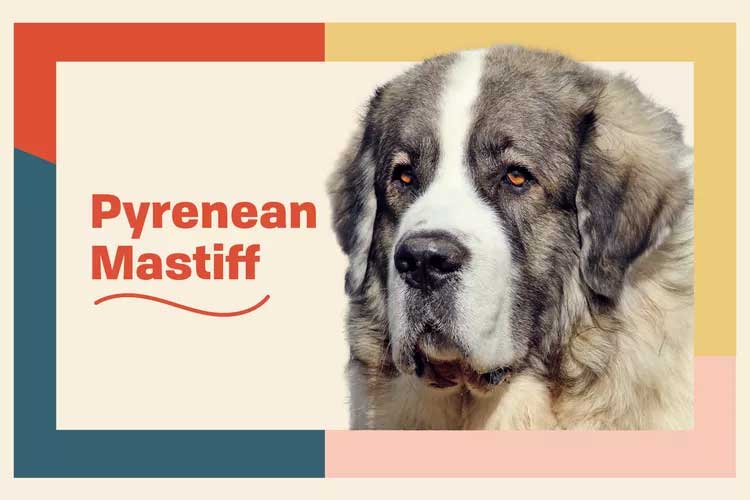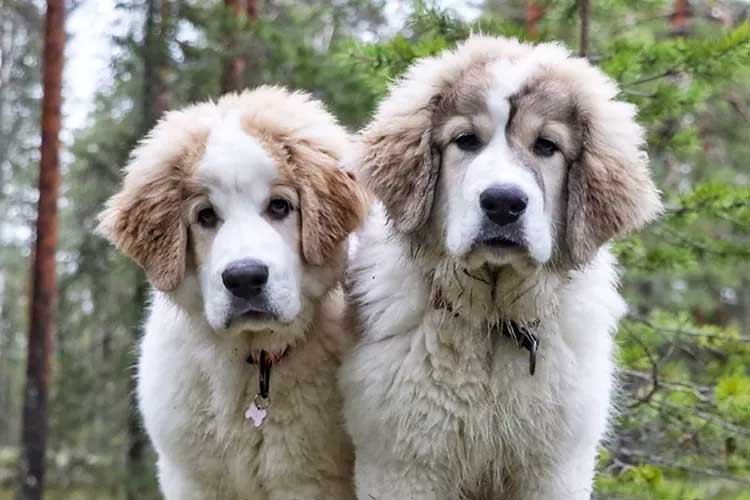Big, calm, and courageous, the Pyrenean mastiff is a large dog originally bred to guard flocks of sheep from predators. Today, these dogs remain rare outside of their native Spain and are typically found on farms.

Pyrenean Mastiff Overview
| OFFICIAL NAME | Pyrenean Mastiff |
| COMMON NAME | Pyrenean Mastiff |
| PET HEIGHT | 28 to 31 inches |
| PET WEIGHT | 130 to 200 pounds |
| LIFESPAN | 10 to 13 years |
| GOOD WITH | cats, dogs, families |
| TEMPERAMENT | aloof, gentle, willful |
| INTELLIGENCE | high |
| SHEDDING AMOUNT | seasonal |
| EXERCISE NEEDS | medium |
| ENERGY LEVEL | calm |
| VOCAL LEVEL | when necessary |
| DROOL AMOUNT | medium |
| BREED GROUP | none |
| BREED SIZE | extra large (101 lbs. or more) |
| COAT LENGTH | medium |
| COLORS | black, blue, brown / chocolate / liver, cream, fawn, gold / yellow, gray, white |
| PATTERNS | bicolor, brindle |
| OTHER TRAITS | cold weather tolerant, high potential for weight gain, requires lots of grooming, strong loyalty tendencies |
The Pyrenean mastiff, also known as the Mastín del Pirineo, started out as a working dog in the mountains bordering Spain and France. Now, about 3,000 years later, these gentle giants are watchful family and farm dogs. They're rare enough that you won't find one at the dog park, but if you're lucky enough to bring one home, you're in store for a loyal companion (and a lot of supersized snuggles).
"When you see a Pyrenean mastiff for the first time, you immediately fall in love with them," says Philippe Normandin, a Pyrenean mastiff breeder at Élevage Sherpa Kennel.
Appearance
The Pyrenean mastiff kind of looks like a Saint Bernard and a Great Pyrenees mix. Along with their massive size (Pyrenean mastiffs can reach 240 pounds and stand 25–31 inches tall), these woofers have a thick double coat that's always white with patches of beige, black, brindle, brown, golden, or gray.
Aside from all that fur, a Pyrenean mastiff is a dog that's muscular from his wide head to the tip of his thick tail. His hazel or dark brown eyes look up sweetly at his favorite humans but warily follow strangers until he knows everything's OK. When something catches his attention, his floppy V-shaped ears partially lift to listen.
Both the Pyrenean mastiff and Great Pyrenees are working dogs from the Pyrenees mountains on the Spanish-French border. And while they both have fluffy white coats and folded triangle-shaped ears, Pyrenean mastiffs weigh twice as much as the Great Pyrenees.
Temperament
According to the Pyrenean Mastiff Club of America (PMCA), these dogs are known to be silent and intelligent. Normandin says Pyrenean mastiffs are "a complete family member.""They will cuddle with the kids … they will lie on the floor and let you brush them as long as you want," Normandin says.

At home, a well-trained Pyrenean mastiff is a great family dog and gentle giant. He's calm, quiet, and prefers to spend the day snoozing (sometimes up to 16 hours a day, Normandin says). But because they were bred to watch over sheep and guard their flocks from predators, Pyrenean mastiffs are always keeping a watchful eye over their family. They'll likely bark to alert you to anything they find concerning, even if it's just a neighbor walking down the street or a delivery person bringing you a pizza.
This natural wariness can make them aloof around strangers, so socializing your Pyrenean mastiff puppy from an early age is incredibly important for him to grow into a polite and well-mannered pet.
Living Needs
Sure, the Pyrenean mastiff spends a lot of time snoozing, but this dog is no couch potato. He needs plenty of room to roam, sniff, and run, Normandin says, and he might not cope well with city life."They are used in Europe as farm dogs, and they are very good with the farm animals," Normandin says. "They would not be a good fit in the city. If you have a backyard for him to express himself, [that's good] … For me, letting my dogs run freely in our yards and look at them playing together is a wonderful pleasure."
Pyrenean mastiffs tend to get along and play well with other dogs and cats (especially if the two are introduced at an early age and properly socialized). They're also calm and gentle around children, though puppy playtime should always be supervised. These dogs love attention from their owners and will often rest their extra-large heads in their human's lap for cuddles and pats.

Daily exercise is a must, but you don't need to be a marathon runner to give your Pyrenean mastiff a good workout. In fact, giant breeds like the Pyrenean mastiff can have problems with their bones and joints as they're growing up, so keep any exercise (especially during puppyhood) low-impact. Take him on a couple of daily walks where he can take plenty of time to sniff, and weekend hikes will make him happy, too.
These dogs love the cold and were bred for mountain life. If you live somewhere with particularly warm summers, it's important to protect your Pyrenean mastiff from the heat. Schedule your walks for the morning and evening (not when the sun is high), and always make sure he has access to shade, AC, and water when it's hot.
Care
Because the Pyrenean mastiff is so big and his fur is so thick, it's no surprise that you're going to have to spend a lot of time brushing him. But don't think of this as a chore. "Brushing your Pyrenean mastiff will be a good time to bond and take time to relax with your dog," Normandin says.
This dog blows his coat seasonally, and frequent brushing will help cut down on the amount of fur clumps scattered on the floor. But no matter how much the fur flies, do not take your pup to be shaved by a groomer; double-coated dogs like the Pyrenean mastiff actually need those layers to stay insulated and comfortable year-round.
Aside from brushing him every other day (or every day, if you can swing it), your Pyrenean mastiff is relatively simple to care for. Normandin says they don't need a lot of baths, and—despite their rather droopy jowls—the breed isn't very drooly when compared to other large dogs, like an English mastiff.
Like all dogs, Pyrenean mastiffs need their nails trimmed so they don't click-clack across the floor. You should also brush their teeth regularly and clean their ears to keep them healthy.

Training your Pyrenean mastiff is all about keeping him engaged. These dogs can be pretty independent-minded, so patience (and lots of treats!) is important.
"They are a little bit curious, so you need to keep them focused on you when training them," Normandin says. "They want to please you, so training with positive reinforcement and treats will be the key."
Health
Pyrenean mastiffs are generally healthy dogs who live about 10–13 years. That said, there are still certain health conditions owners need to stay vigilant for.For one, those cute, droopy eyes can develop some problems. Pyrenean mastiffs can be prone to eye infections, entropion (a condition where the eyelids turn inward), and ectropion (where the eyelids turn outward).

Along with eye issues, these large dogs can develop hip dysplasia, which happens when the hip joint doesn't develop properly. Pyrenean mastiff puppies are also slow to mentally mature but, physically, they grow very quickly; this can lead to panosteitis, commonly referred to as "growing pains."
Because these pups grow into large, barrel-chested dogs, gastric dilation volvulus (or "bloat") is something all Pyrenean mastiff parents need to be aware of. Bloat is a life-threatening condition and needs to be addressed by a veterinarian right away. Talk to your vet about the signs of bloat and whether a gastropexy surgery is recommended for prevention.
One last thing: While using treats during training sessions can keep your pup focused on you and ready to learn, don't feed him too many snacks. Otherwise, he can quickly pack on the pounds.
History
As an ancient breed, the Pyrenean mastiff's history is very much intertwined with the history of Spain. Phoenician traders acquired mastiff dogs in Sumeria and Assyria about 3,000 years ago and brought them to present-day Spain on their travels, according to the breed club. The dogs were sold and, over the centuries, the mastiffs worked hand-in-paw with shepherds to move sheep flocks through the mountains and protect them from wolves and bears.
In 1659, Cardinal Mazarin (the Regent of France) and Philippe IV (the King of Spain) signed a decree. France took control of the northern Pyrenees mountains, and Spain maintained control of the south. This split didn't just affect the mountains, but the dogs, too. On either side of the border, the flock guardians were further refined until the Great Pyrenees and Pyrenean mastiff became two separate, distinct breeds—the Pyrenean mastiffs on the Spanish side, the Great Pyrenees on the French side.
But in the 1930s and '40s, Pyrenean mastiffs began to disappear. Wolves and bears vanished from the mountains, and farmers struggled to satisfy the dogs' big appetites after the Spanish Civil War. The giant dogs almost became extinct but were revived by breed enthusiasts.
The Pyrenean mastiff isn't yet recognized by the American Kennel Club, but the dogs are part of the organization's Foundation Stock Service, which puts them on the path to full recognition.
Fun Facts
Pyrenean mastiffs were once known as Navarra mastiffs.A rare dog breed, the PMCA estimates that there are only about 4,000–6,000 Pyrenean mastiffs worldwide.